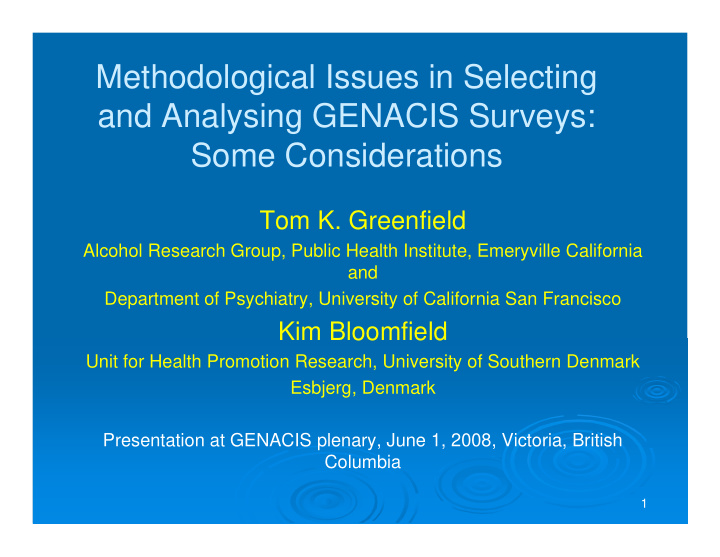



Methodological Issues in Selecting and Analysing GENACIS Surveys: Some Considerations Tom K. Greenfield Alcohol Research Group, Public Health Institute, Emeryville California and Department of Psychiatry, University of California San Francisco Kim Bloomfield Unit for Health Promotion Research, University of Southern Denmark Esbjerg, Denmark Presentation at GENACIS plenary, June 1, 2008, Victoria, British Columbia 1
Overview Here we take up some thorny methodological issues related both to Selecting and Analyzing GENACIS surveys. We raise a number of questions for which there are as yet no clear consensual answers, to spark discussion At the end we give an example involving a HLM analysis taken from work being presented in the main meeting: Greenfield, TK, Bond J, Ye Y, Lapp B, Nayak M, Kairouz S, Rehm J, Monteiro MG, Obot IS, Plant M, Rahav G, Kuendig H, Kuntsche S, Ibanga A, Allamani A, Vidal A, Wilsnack S, and Ahlström S. "Gender differences in public and private drinking contexts: a multi-level GENACIS analysis." Paper presented at the 34th Annual Alcohol Epidemiology Symposium of the Kettil Bruun Society for Social and Epidemiological Research on Alcohol, Victoria BC Canada, June 2-6 . 2
Point of departure Decision rule: In deciding which data sets to use in a GENACIS analysis, one should first rely on the criteria found in the guidelines for participation in the GENACIS project (see sample characteristics and survey methods) as a “gold standard”. These include: a sample size of at least 1000 inclusion of men and women (18+ years) use of probability sampling national sample preferred 70% + completion rate Use of GENACIS expanded core questionnaire (or at least core). 3
Issues to consider when selecting or analyzing GENACIS data When not all desired countries or variation can be achieved using the above criteria, then the following should be considered in selecting the next best samples for your analysis: 1 Compatibility of variables, especially if survey isn’t core questionnaire. Can the variables be considered “close enough”? Are any ‘fixes’ legitimate or possible? Some variables may be fundamentally flawed – avoid? 2. Survey year (Epoch/type of the survey). Some non-GENACIS data sets (e.g., ECAS, France) in GENACIS data bank but may not have comparable variables (e.g. Austria). Several countries have newer, better data (e.g., for US use 2000 rather than 1995 NAS; Brazil). 3. Sampling frames in many cases are not truly national; some are region/s, state/s, or even town/s (how broad, i.e., estimated coverage? How representative?) Designs and methods differ. Some areas selected as ‘heavier drinking’. Consider how best to analyse and report the results when not representative of country. Should some analyses stratify by region? 4
Issues to consider when selecting or analyzing GENACIS data 4. Sampling designs differ (e.g., household multi-stage, clustered vs. RDD). Some are “unique”. Response rates, if reported, may mean different things (e.g., cooperation rate vs. true response rate). Response rate inherently means different things in different survey designs. Is weighting needed (depends on purposes); but quality of weights may differ. 5. Interview modalities differ: telephone, face-to-face; postal; mixed. 6. Age ranges included differ (18-65 or wider age range?). Consider restricting age range—all ranges seem to include 18-65 (check?). 7. Distributions of men and women differ. Some face-to-face interviewing conducted only during daylight hours for safety reasons; in these cases, who were the men included?—out of work or underemployed? Retired? Sick? Stay-at-homes? 5
Issues to consider when selecting or analyzing GENACIS data 8. Rates of drinking in some places vary greatly by gender—are all demographic subgroups sufficiently represented among women and are women drinkers subgroups adequate (subgroup analyses by gender may need to consider Ns) 9. Missing data—is the amount small enough to ignore? Multivariate analyses compound the problem. Are there possibilities for imputation? Methods to use 10. Should methodological differences be taken account of, and if so how? 11. Given regional, state, local or other sampling frame, how best to characterize “contextual” or “cultural” influences? Country-level or survey aggregated values 6
Issues to consider when selecting or analyzing GENACIS data 12. Availability of information on GENACIS samples; what to do when information is fundamentally “unknown”? 13. Special issues related to drinking variables; Generic Volume is last resort. 14. Discussion of limitations in papers: how far to go?! Value of transparency. Apply group-wise or individual research ethics (or both). Resources: A. Country Methodology Issues Table (Under Development) B. GENACIS Codebook + Cook7book C. Collective Wisdom especially ISPA and NODAK Example from HLM Contexts paper on public & private venues (Greenfield, Bond et al. KBS2008) 7
Recommend
More recommend